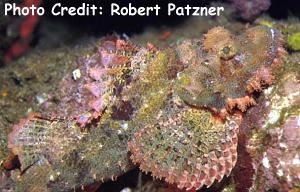
By Bob Goemans

Not Reef Tank Suitable
Likely Fish-Only Tank Suitable
Range: Indo-West Pacific Ocean: Red Sea to Mariana Islands, east to Taiwan, and south to the Great Barrier Reef.
Size: 14 inches (35 cm)
Natural Environment: Inhabits bottom rubble areas in reef channels and on reef faces and fore-reef slopes at depths between 3 - 250 feet (1 - 75 m) where it feeds mainly at night on small fishes and crustaceans.
General Husbandry: One of the more attractive species in this family, having a mottled brownish coloration on its body and fins along with several appendages/flaps of skin on the jaw and chin areas. Body color can somewhat, match the color of the substrate its sitting on.
Best maintained in aquariums with minimum water currents, as this is an inactive species that stay in one place on bottom substrate while waiting for a meal to come close enough to be captured/engulfed and eaten. Aquarium environment should have caves and ledges to hide, as this a highly secretive species. Tankmates must be peaceful so as not to nip its large fins, and large enough not to be eaten.
As to diet, these fish are carnivores and require a diet high in protein and amino acids (lipids/fats). Products such as marine fish and crustacean flesh, clams, and other marine meaty foods should make up the majority of their diet.
As to live foods, occasional small live mollies and/or guppies can provide for that natural feeding excitement found in the wild should live marine fish not be available. Nevertheless, feeding small freshwater live fish should be considered a special treat and not become a steady diet since they lack the fatty acids that marine fish need to stay healthy.
Also, keep in mind that feeder goldfish, which cannot survive but a few minutes in seawater, also carry many different bacteria, fungi, and protozoa that can cause parasitic and infectious diseases. Furthermore, feeder goldfish can also cause blockage in the digestive track and/or kidney along with liver damage due to fatty degeneration in the consuming fish. And this will ultimately lead to the consumer’s death. In fact, fatty liver degeneration is a common cause of death in cases where marine fish are fed a diet that primarily consists of goldfish (as with Lionfish for example). Also, its possible the large air bladder in the goldfish can upset the internal balance in this fish, sometimes causing it to float at the surface, possibly killing it.
Non-living foodstuffs can be suspended/impaled on a long thin stick and dangled within range to entice feeding.
Because these are sedentary fish, their metabolism is quite low and three or four feedings per week should suffice nicely.
May be difficult to feed in the early days in the aquarium and if so, (if live marine fish are not available) live glass/grass shrimp and/or small crabs, e.g., fiddler crabs may be needed to sustain the fish.
Taxonomy:
Order: Scorpaeniformes
Suborder: Scorpaenoidei
Family: Scorpaenidae
Subfamily: Scorpaeninae
Genus: Scorpaenopsis
FYI: Highly venomous, - has very poisonous spines on its back - take special care when your hand is near this species!
Best maintained in its own private environment.
Partly burries itself in the substrate.
One per aquarium.
Sometimes referred to as one of the species in the ‘Tasseled Scorpionfish’ Group.
Experience Level: Intermediate
Temperament: Semi-aggressive
Diet: Carnivore
Coral Safe: Yes
Fish Safe: With caution
Invertebrate Safe: With caution
Acclimation Time: 30 minutes+
Aquarium Environment: Fish-only aquarium
Tankmates: Peaceful
Minimum Tank Size: 75 gallons
Temperature Range: 72 - 80°F (22 – 27°C)
Specific Gravity: 1.020 - 1.026
pH: 8.0 - 8.5
